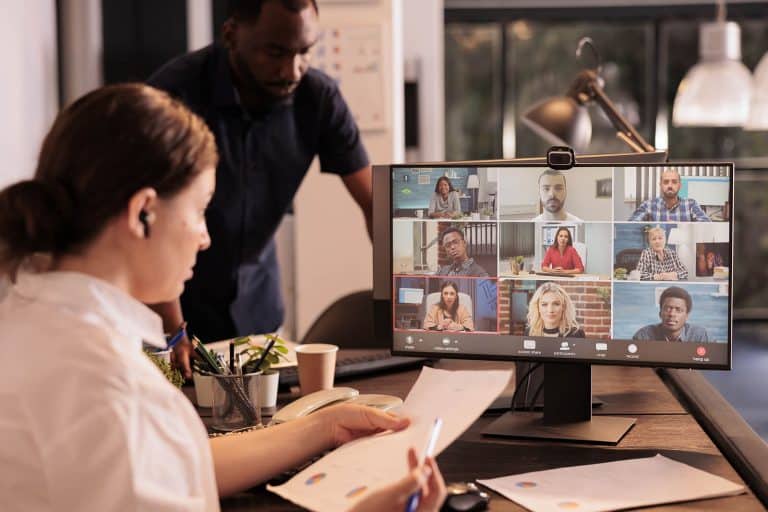Counter-effects of the pandemic protocol have forced companies to shut down their logistics and operations in offices. This has led to an increase in remote work arrangements. More than 60% of employees were working from home, and remote work posed challenges to maintaining the confidence and morale of employees. Many companies now use employee monitoring systems to keep workers productive while working from home, primarily employee monitoring software.
Table of Contents
ToggleIn a post-pandemic world, companies are considering whether to continue working in offices, wholly or partly. And the new normal now includes employee behavior analysis, apart from employee monitoring.
Employee monitoring – What does it indicate?
Employee monitoring refers to the arrangements employers make to monitor their workplaces and the activities of their employees. Employee monitoring systems only include specific techniques such as network and e-mail monitoring or staff monitoring software, video surveillance, time clocks, GPS systems, and biometric technology.
Employee monitoring is often referred to as remote monitoring or just workplace monitoring. This is a growing trend – companies use digital tools to keep employees engaged, track work, check employee performance, and work on progress. Businesses use various monitoring methods to measure productivity, track attendance, evaluate behavior, ensure safety, and gather evidence of working hours.
Employee monitoring software
Employee monitoring software monitors employee productivity and work efficiency and allows company administrators to manage their employee computers from a central location. It is typically deployed over the business network and allows easy, centralized log viewing through a main network PC. The software monitors employee performance, prevents illegal activities, curbs confidential information leaks, and captures internal threats. Nowadays, employee monitoring software technology is widely used even in BPOs and call centers.
Employee monitoring programs can monitor almost everything on a computer, such as keystrokes and passwords, websites visited, chats on Facebook Messenger, Skype, and other social platforms. Part of the monitoring software can also capture screenshots of mobile activities. E-mail monitoring involves the employer having access to the e-mail records of employees sent through the company’s servers. Companies can use a keyword search for natural language processing for e-mail analysis. Administrators can view logs through the cloud panel or receive records via e-mail.
Why is monitoring employee productivity important?
Here are the main reasons companies keep an eye on employees in the workplace.
- Bandwidth Management: Network monitoring software is used to track bandwidth usage. This feature helps identify time spent on channels like YouTube, Netflix, and other social media sites.
- Employee Productivity: Workforce productivity management software monitors internet usage for unrelated web activities beyond what is officially defined.
- Workforce Management: Staff monitoring is a great way to analyze specific work activities. The data obtained from the analysis helps in making timely business decisions.
- Prevention of Data Loss: Employee access to sensitive data can be closely monitored. Unauthorized access statistics are used to take protective measures against data breaches and internal leaks.
- Protection of Legal Liability: Companies are responsible for their employees’ work. Monitoring employees’ activities improve the visibility of employees’ behavior.
- Software Asset Management: Employers also monitor applications used to determine whether they are licensed.
Project management
To thrive in today’s competitive market, project tasks need to be managed as efficiently as possible. As a manager, you are responsible for ensuring that your team completes each task on time, and for that, you will need a task management tool.
A sense of insecurity among employees makes them reluctant to welcome new tools. Changes can be difficult to accept, especially if your employees do not know the benefits. Be proactive and help your employees understand that project management tools are a great way to manage and execute business activities.
Task management tool
Task manager is a program that simplifies workflow and project management. A task management tool is a software solution for project management. Now, it is just a matter of opening the software to find out how efficiently the team is working, setting a task for the employees, and controlling its execution.
In other words, a task management tool is a software solution used in project management, mainly focused on work activities. It is used to facilitate workflows and gain better control over micro activities such as finding out how efficiently the project team is working, setting tasks and work priorities for employees, monitoring and controlling execution, and so on. Project management software is a popular tool to control general management and short-time projects.
Employee management tool
Employee task management software combines several great functions, from co-worker interactions to workflow monitoring. There are tools designed specifically to manage work-related activities.
Employee management is a process that helps your employees do their best and achieve your business objectives. It is a holistic process that involves almost everything related to human resources, such as new staff recruitment, pay management, performance management, and so on.
Employee management covers three major areas:
- Acquisition – Getting the right candidate
- Engagement and Retention – Ensuring your employees remain satisfied, engaged, and retained for longer tenures by providing healthy work practices and active communication.
- Performance Management – Evaluating work performance and conducting timely evaluation reviews to improve and reward excellent work continuously
Effective management usually depends on the ability of individual managers and their subordinates to be motivated, communicate effectively, and build trust. Good managers act as trainers for their employees, motivating them to improve by recognizing the best work they are currently doing.
Employee management is a process that helps your workers perform and achieve your business goals. It’s a holistic process that covers almost everything related to human resources, such as new employee recruitment, payroll management, performance management, etc.
An employee management system is a software that guides and manages the efforts of employees. The software securely stores and manages your employees’ personal and other work-related details on a centralized platform.
Human resource managers usually perform functional responsibility for employee management. They use a special line of software in the human resource management system.
Human resource management system
A human resources management system (HRMS) or human resources information system (HRIS) or human capital management (HCM) is a kind of HR software that blends several processes. Human resources software is used by businesses to combine several such essential HR functions as storing employee data, managing payroll, recruitment, benefits administration, time and attendance, employee performance management, and tracking of competency and training records.
The human resource (HR) software is also known as:
- Human Resource Management System (HRMS)
- Human Resource Information System (HRIS)
- Human Capital Management (HCM)
They combine multiple systems and processes to easily manage human resources, employee data, and business processes.
The human resource management system also makes sure that daily human resource processes are accessible and in control. It combines human resources discipline with its basic HR activities and processes, including IT-related functions, while the programming of data processing systems has evolved into a package of standardized routines and enterprise resource planning (ERP) software. Overall, this ERP system originates from software that aggregates information from a variety of applications into one universal database. The relationship between its financial and human resource modules through the database is the most important difference concerning the predecessors developed individually and as proprietary, making this software application rigid and equally flexible to be integrated into workflows.
With an increasing emphasis on the well-being of employees, HR will need appropriate technology to improve the employee experience. Machine learning developments in AI, predictive analytics, IT, and HR processes are the way forward.
HR management – is it an extension of personal management?
Personnel management (PM) is what we know as traditional personnel management. Human resource management has emerged as an extension of traditional personnel management.
The main differences between personnel and human resource management lie in their scope and orientation. The scope of staff management is limited, and there is a reverse approach in which workers are seen as a tool. Here the behavior of employees can be modified according to the basic capabilities of the organization.
On the other hand, human resource management has a wider scope, and they consider employees as the property of the organization. It promotes reciprocity in terms of objectives, responsibilities, rewards, etc., which will help in enhancing economic performance and high-level human resource development.
Employee monitoring vs employee management
Finally, although the two functions overlap somewhat, they were devised for different purposes. Workplace surveillance and personnel management monitoring software are primarily meant for human resource tasks.
Can employee monitoring software for remote teams complement staff management tasks? Maybe yes, to an extent.
Employee monitoring software can benefit your remote and in-office teams. The extended feature of good employee monitoring software complements the add-on functions in employee management tools.
Companies have turned to modern project management platforms to facilitate planning and workload distribution. Those who opted for high-level computer activity monitoring platforms while working remotely did so, to some extent, because they also integrated the project management system.
Employee monitoring software with a built-in task management function gives you an accurate picture of what each employee is working on at any given point in time and how their actions relate to their time management skills. Managers then determine if their team members work urgently for high-value assignments or waste their time on trivial tasks. Employee tracking is different from time tracking. The former traces the details of all the employees present in the organization, while the latter is usually used to track the time spent on tasks to complete a project.
- Resource allocation – Employee monitoring software contains employee data, location, workload assignments, and progress. These factors help management review the situation, change priorities, and bring a more balanced workflow.
- Employee activity tracking software can also serve as a first-aid kit when a project is hit. This provides business owners and managers with options to investigate the source of the problem (inadequacy or unavailability of tools, lack of skills, bad time management, etc.).
- Productivity and accountability – In a healthy working environment, responsible and introspective employees find this software useful for self-evaluation of their working habits. Having access to productivity insights often makes employees aware of their productive times and tends to reduce the time on less important tasks and help in refocusing on work after an interruption.
- Attendance monitoring – Using mouse-and-keyboard activity to track production time, the primary feature is to track the level of complex employee attendance in and out of the clock. The devices can measure idle time and active time spent in the target areas.
- Payroll management – Attendance hours captured can also be linked to a payroll system that can automatically automate things like timesheets, invoices, and payments.
- Record-keeping – Keeping accurate records may not seem like an effective use of employee tracking software, but it can be useful. You can track employee behavior patterns, project timelines, security levels, etc. Regardless of the information, you want to track. Staff monitoring software can help you keep accurate and comprehensive records.
Going forward
Providers of employee monitoring software are developing a new task management platform that will include organization-wide functions in operations management. This category of software has the potential for end-to-end functionality in employee monitoring, time tracking, and HR management.
This software is made up of major modules, for example:
- Screen Recording
- Face Recognition
- Work Time
- Work Output
- Assets Optimization
- Workflow Management
- Advanced Analytics
Achieving effective and efficient staff management through innovative software systems can take businesses to the next level with increased productivity and employee satisfaction.
With the power of employee management software, employers can accurately maintain employee records, from business appointments to resignation or retirement. Using employee management software is an innovative way to boost employee engagement and increase employee retention, ensuring that the backbone of your business stays strong.




